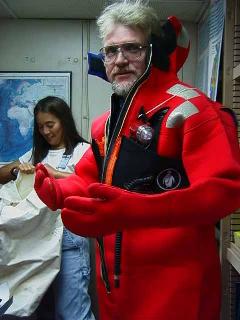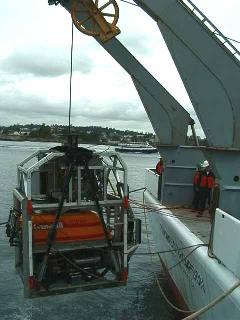WHAT'S NEW:
BACKGROUND:
Mission
Project Description
Cruise Plans:
Participants
Technology (ROV, ships, etc.)
Future Plans
Results:
1998 NeMO Cruise
Axial 1998 "Eruption"
Logbook
June 21, 1999
June 21, 1999
Contents:
- News from Thompson
- News from Wecoma
- Participant Perspective
- Logbook from Teacher at Sea
- Question/Answer from shore to sea
Thompson Science Report
See perspective below.
Wecoma Science Report
See teacher's log below.
Listing of all Science News postings
Life at Sea: Participant Perspective
PERSPECTIVE ON NeMO 99
Bob Embley
Listing of all Perspectives postings
Day 6, Monday 6/21/99
On the stern of the
Wecoma is a large A-frame and winch for use on
deployment of heavy scientific equipment.
Dr Richard Feely, an
oceanographer from NOAA/PMEL, gave me operating instructions on the use of
the winch: how to pay out the wire; what to say to the crew and bridge
while serving as the operator. Our mission was to set up the rosette with
MAPR
(Miniature Autonomous Plume Recorders) strapped to the base of
the frame. This cast will be the first time this technique will be tried.
The MAPR's are self-contained instruments that record data from
temperature, pressure and nephelometer sensors.
Using the dry-lab's computer, data collected from this cast will be saved
on computer disk.
Sharon Walker, NOAA oceanographer, will be using the information
to detect hydrothermal temperature and optical anomalies. These samples
and records give the scientists a clearer picture of the plume in the
water column. It is only in the past few cruises to the Axial Volcano site
that these detailed records have been kept. Our knowledge of hydrothermal
vents and plumes is growing at a rapid rate through the work of the
scientists.
The weather has been constant over the day. High in the mid 50's, winds 15
knots with seas of 4-5ft.
A highlight of the afternoon was spotting 2
Sei whales off the starboard
side of our vessel. I was able to watch them move across the horizon for
almost 15 minutes. A field guide was helpful in identifying this mammal.
Watching its blow and measuring the distance to its dorsal fin, along with
size and shape helped the identification process.
I continue to observe how well this ship functions 24 hours a day.
Amazing.
Come aboard tomorrow for more information on the
EOI Program and it's
scientists.
Fair seas,
Thompson Teacher at Sea Log #2 Monday 6/21/99
Our adventure began at about 1400 (2:00 p.m.) yesterday when we finally set
sail from the Port of Victoria. At
about 1845 (6:45 p.m.) we stopped and tested the ROV ROPOS in deeper water
to check the various systems and give it a pressure test. The test was
carried out in about 28 meters of water. All systems appeared to be working
fine so it
As I close this message we are about 83 nautical miles from our destination where we as
a team hope to develop a new baseline understanding of what is now happening at Axial
Volcano and the associated vent sites. If you remember a
year ago the team researched in
depth what happened during the
1998 eruption and came away with a great deal of data
and new ideas. We will be filling you in on some of the findings from that voyage along
with what is going on out here this year so stay tuned for more.
Bye for now.
Logbook of all Teacher At Sea postings
 Hi, I'm
Hi, I'm
Teacher At Sea Logbook
Ms. Deck
 was brought back aboard and tied down for the voyage. Getting an ROV off
and on a ship is no easy task. Each time ROPOS leaves the ship, safety
measures must be taken to ensure that it won't come crashing back into
the boat due to the never ending undulations of the water. To sufficiently
secure ROPOS from swinging free, 5 lines are manned from various angles
and they provide tension so that ROPOS can be lifted off the deck and
place directly into the water behind the ship. A chief mate (person in
charge of conducting back deck operations) directs the crane operator
along with those manning the lines. Once ROPOS is in the water and after
it has completed its mission, 3 cable lines are attached when it reaches
the surface. These provide the same function coming back on board as the
five manned lines going out. These 3 lines are powered with winches which
are each manned by crew members who know what's going on. Keeping ROPOS
safe and secure is no easy job, nor is it one that is taken lightly. If
there is a down time on a scientific voyage, we experienced it late last
night and earlier this morning while still in transit to the field site.
Labs were empty and the technicians and scientists that man them were
not to be found. The effects of being at sea could also have something
to do with this. As the ship makes it way to the site of Axial Volcano
we seem to be rolling back and forth a lot. Try typing a term paper on
a children's roller coaster or a rapidly changing elevator. Besides teaching
high school science, I also coach basketball. We call a specific positioning
of the players body when they catch the ball a "Triple Threat" position
(you can shoot, pass or dribble from it). Well, on board a ship rolling
along I've been practicing that position a lot trying to keep my balance,
walk in a straight line and not loose my dishes during meal breaks.
was brought back aboard and tied down for the voyage. Getting an ROV off
and on a ship is no easy task. Each time ROPOS leaves the ship, safety
measures must be taken to ensure that it won't come crashing back into
the boat due to the never ending undulations of the water. To sufficiently
secure ROPOS from swinging free, 5 lines are manned from various angles
and they provide tension so that ROPOS can be lifted off the deck and
place directly into the water behind the ship. A chief mate (person in
charge of conducting back deck operations) directs the crane operator
along with those manning the lines. Once ROPOS is in the water and after
it has completed its mission, 3 cable lines are attached when it reaches
the surface. These provide the same function coming back on board as the
five manned lines going out. These 3 lines are powered with winches which
are each manned by crew members who know what's going on. Keeping ROPOS
safe and secure is no easy job, nor is it one that is taken lightly. If
there is a down time on a scientific voyage, we experienced it late last
night and earlier this morning while still in transit to the field site.
Labs were empty and the technicians and scientists that man them were
not to be found. The effects of being at sea could also have something
to do with this. As the ship makes it way to the site of Axial Volcano
we seem to be rolling back and forth a lot. Try typing a term paper on
a children's roller coaster or a rapidly changing elevator. Besides teaching
high school science, I also coach basketball. We call a specific positioning
of the players body when they catch the ball a "Triple Threat" position
(you can shoot, pass or dribble from it). Well, on board a ship rolling
along I've been practicing that position a lot trying to keep my balance,
walk in a straight line and not loose my dishes during meal breaks.
Questions & Answers
![]() Send Your Question to NeMO
Send Your Question to NeMO
(oar.pmel.vents.webmaster@noaa.gov)
![]() Back to Calendar
Back to Calendar